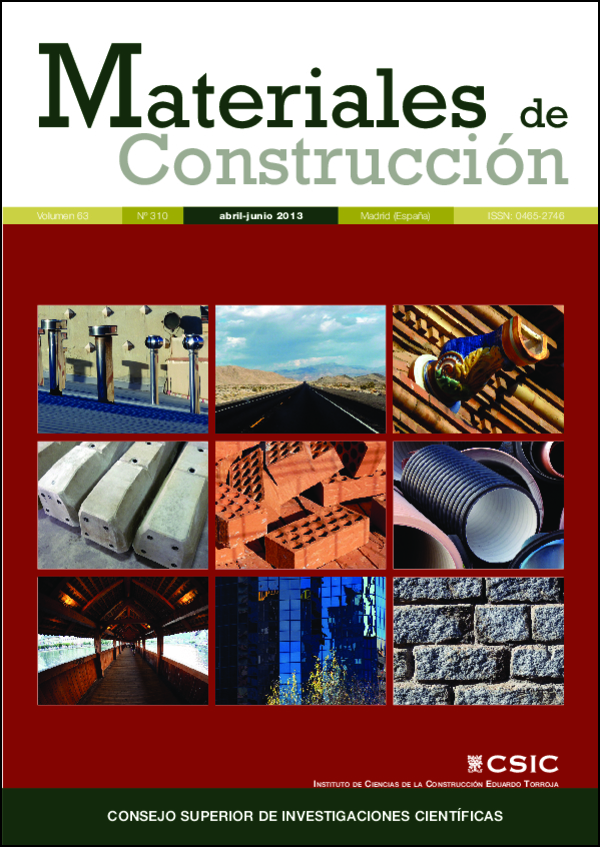Behaviour of Temporary Edge Protection Systems of high density polyethylene tested to static and impact load
DOI:
https://doi.org/10.3989/mc.2012.07111Keywords:
Polymer, Fiber reinforced, Composite, Flexural strength, CreepAbstract
We have tested under static and dynamic load temporary edge protection systems (TEPS) formed by a continuous fence, some are made of high density polyethylene (HDPE) and others have been manufactured using a composite material, adding glass fiber at a matrix of HDPE at a rate of 4%. Tests under static and impact have been performed according to standard UNE-EN 13374, class systems A and B. It has been found the influence of aging on TEPS and samples of the same materials as the TEPS. All tested TEPS exceed the strength requirements and accidental load and requirements compared to dynamic loads. The incorporation of glass fibers results in a composite material with a modulus of elasticity higher and significantly less creep. We haven’t seen dependence on the results with the degree of aging or in SPPB or in the samples.
Downloads
References
(1) Johnston N.J., Towell, T.W., Hergenrother, P.M.: Physical and mechanical properties of high-performance thermoplastics polymers and their composites, pp. 27-71. In: Carlsson L.A., editor. Thermoplastic composite materials. Elsevier Science Publishers B.V. Amsterdam, (1992).
(2) Peacock A.J.: Handbook of polyethylene. Structures, properties and application, Marcel Dekker, Inc. New York, (2000).
(3) Antequera, P., Jiménez L., Miravete, A.: Los materiales compuestos de fibra de vidrio, Secretariado de Publicaciones Ciudad Universitaria Geológicas, Zaragoza, (1991).
(4) Kim, H.C., Glenn, L.W., Ellis, C.S., Miller, D.E.: "Selecting long-glass fibre/thermoplastics for creep resistance". Plast. Eng., Vol. 53, nº 1 (1997), pp. 39-40.
(5) Markarian, J.: "Long fibre reinforced thermoplastics continue growth in automotive". Plast. Addit. Compound, Vol. 9, nº 2 (2007), pp. 20-24. http://dx.doi.org/10.1016/S1464-391X(07)70025-9
(6) Osswald, T.A., Baur, E., Brinkmann, S., Oberbach, K., Schmachtenberg, E.: International plastics handbook: the resource for plastics engineers. 4th ed., Hanser, Cincinnati, (2006).
(7) Nguyen, B.N., et al.: "Fiber length and orientation in long-fiber injection thermoplastics. Part I: Modeling of microstructure and elastic properties, Vol. 42, nº 10 (2008), pp. 1003
(8) Yang, S.W., Chin, W.K.: "Mechanical properties of aligned long glass fiber reinforced polypropylene. I: Tensile strength", Polym. Compos., Vol. 20, nº 2 (1999), pp. 200-206. 257-264.
(9) Houshyar, S., Shanks, R.A., Hodzic, A.: "Tensile creep behaviour of polypropylene fibre reinforced polypropylene composites", Polym Test., Vol. 24, nº 2 (2005), pp. 257-264. http://dx.doi.org/10.1016/j.polymertesting.2004.07.003
(10) Bartus, S.D., Vaidya, U.K.: "Performance of long fiber reinforced thermoplastics subjected to transverse intermediate velocity blunt object impact", Compos. Struct., Vol. 67, nº 3 (2005), pp. 263-277. http://dx.doi.org/10.1016/j.compstruct.2004.07.023
(11) AENOR-CEN. UNE-EN 13374. Sistemas provisionales de protección de borde. Especificaciones del producto, métodos de ensayo, Asociación Española de Normalización AENOR, (2004).
(12) UNE-EN 596. Estructuras de madera. Métodos de ensayo. Ensayo de choque por cuerpo blando sobre muros entramados de madera, Asociación Española de Normalización AENOR, (1996).
(13) UNE-EN ISO 4892-2. Plásticos. Métodos de exposición a fuentes luminosas de laboratorio. Parte 2: Lámparas de xenón, Asociación Española de Normalización AENOR, (2006).
(14) UNE-EN ISO 178. Plásticos. Determinación de las propiedades de flexión, Asociación Española de Normalización AENOR, (2003).
(15) UNE-EN ISO 179-1. Plásticos. Determinación de las propiedades al impacto Charpy. Parte 1: Ensayo de impacto no instrumentado, Asociación Española de Normalización AENOR, (2001).
(16) Cobo, A.; González, M.N.: “Study of temporary edge protection systems using different standars”. 37th IAHS World Congress on Housing Science. Design, Technology, Refurbishment and Management of Buildings, Santander, (2010).
(17) González, M.N.: “Consideraciones respecto a los sistemas provisionales de protección de borde”, Tesis Doctoral, Universidad Politécnica de Madrid, España, (2010).
(18) González, M.N., Cobo, A., Fuente, J.V., Bresó, S., Lozano, C.: “Comportamiento bajo cargas estáticas de sistemas provisionales de protección de borde realizados con elementos de acero”, Informes de la Construcción, Vol. 63, nº 521 (2011), pp. 57-67.
(19) OSHA. Part 1926. Subpart M CFR 1926.500 – Fall Protection for the Construction Industry, Occupational Safety & Health Administration, US Department of Labor, Washington, D.C., (1998).
Downloads
Published
How to Cite
Issue
Section
License
Copyright (c) 2013 Consejo Superior de Investigaciones Científicas (CSIC)

This work is licensed under a Creative Commons Attribution 4.0 International License.
© CSIC. Manuscripts published in both the print and online versions of this journal are the property of the Consejo Superior de Investigaciones Científicas, and quoting this source is a requirement for any partial or full reproduction.
All contents of this electronic edition, except where otherwise noted, are distributed under a Creative Commons Attribution 4.0 International (CC BY 4.0) licence. You may read the basic information and the legal text of the licence. The indication of the CC BY 4.0 licence must be expressly stated in this way when necessary.
Self-archiving in repositories, personal webpages or similar, of any version other than the final version of the work produced by the publisher, is not allowed.
















